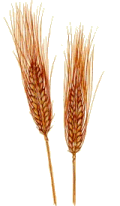| |
beer making
by Willard Clarke and Tom Stevenson
Beer is made by adding water to a grain like barley or wheat. The grain is malted (allowed to germinate and then heated or roasted) and the brew is invariably flavoured with
hops. Hops are the flowers of a climbing vine that contain compounds and acids that impart flavours and aromas to beer. These are often the bitter flavours that make
beer savoury and interesting, and the hop variety is important to the finished beer's flavour. This extract of water, malt and hops is then fermented. Fermentation uses yeast, which reacts with sugars in the grain, converting them into alcohol.
The other by-product of the fermentation process is Carbon Dioxide, the gas which bubbles through a beer (and through Champagne for that matter). Many bottle-conditioned and cask-conditioned beers use only this natural carbonation to
make them gently fizzy. More commercial beers will be doused with C02.
Grains other than barley and wheat, and flavours other than hops, are used in a few specialist beers. Everything from chocolate to oysters might be used as a flavouring for
speciality beers - whether the purists approve or not.
The final
alcoholic strength of beer is expressed as a percentage of Alcohol By Volume (ABV). This typically will range between around 4% and 8%, though some specialist beers can go much higher. Low- and non-alcoholic beers exist, but
the interest and quality of these are both minimal.
A quick check list of the beer-making stages:
|
|

|
Malting
Grain is soaked in water and allowed to germinate, then heated to produce malt.
Milling
The malt is milled to produce a fine mixture called grist.
Mashing
The grist is mixed with hot water, releasing starch in the form of sugar. This sugary solution is known as the "wort".
Boiling
The wort is boiled with hops in copper kettles to release the hop's bitter flavours.
Fermentation
Yeast is added to the wort, converting the sugars into alcohol and carbon dioxide.
Conditioning
Depending on the type of beer, it may be run straight into casks or "fined" (clarified).
Filtration
Most beers other than "live" ales are filtered to make them truly "bright".
Pasteurisation
Flash-heating keeps the beer fresh and avoids the risk of bacterial spoilage.
You may be able to tell the difference between a glass of bitter, mild, stout or lager just by looking at the stuff, but as they are all essentially fermented from malted barley with a handful of hops, have you ever wondered what is it that
makes each so different? Different hops, where they grow and the source of water all play a part, but perhaps the simplest difference worth grasping is that between the two basic categories of beer:
so-called "top-fermented" and "bottom-fermented".
The earliest ales were all "top-fermented" in open vessels, but this term did not creep in to our beerspeak vocabulary until after the Germans had developed the first so-called "bottom- fermented" beer circa 1420 (the first documented mention of "bottom-fermented" beer). It was the brewers in the Bavarian Alps who discovered that beer lost its natural cloudy appearance when stored in mountain caves. They were unaware of the reason, that the ice-cold temperature caused the yeast and other sediments to fall to the bottom of the vessel. In fact, they did not even know about the existence of yeast in beer or its role in the fermentation process. They did, however, know that when beer was being made they could see the frothy effect of fermentation on the top of the liquid, which bubbled away ferociously, but at colder temperatures this activity was much less noticeable, produced a starbright beer (not necessarily pale, as some lagers are quite dark in colour) and when the beer was removed, they discovered a residue of fermentation matter collected at the bottom of the vessel, from which they concluded it was "bottom- fermented".
When scientists began to understand the behaviour of yeast in the 19th century, brewers started to develop various different strains of yeast specifically for either "top-fermented" or "bottom-fermented" beers and over the years traditional practices have evolved so that we can new roughly define the following:
"Top-fermented" Beers are fermented at warmer temperatures (commonly 20�C/68�F) with air-contact and stored preferably for no more than a couple of days or, at most, a couple of week (there is not benefit derived from the maturation process), but at a normal temperature, not chilled.
"Bottom-fermented" Beers are fermented at colder temperatures (commonly 8�C/46�F) with as little air-contact as possible and cold-stored for as long as possible (six months was once considered the minimum and some brands of limited production still maintain this standard or even higher, but most large- volume commercial brands are aged for less than six weeks).
We can lump all traditional British beers, from bitter to stout, plus wheat beers and German Altbier and K�lsch, into the "top-fermented" category, whereas every lager style and all American
malt liquors are classified as "bottom-fermented". You will find an explanation of these and other generic beers in the Beer glossary, together with a brief description of continental Europe's most
famous brands, plus a number of slightly more obscure beers, including some draught and seasonal brews.
The ideal drinking temperature for a beer is directly related to its temperature of fermentation, thus a "bottom-fermented" beer such as a lager should be chilled, while a
"top-fermented" beer like bitter should not (though it should never be warm; just a good cellar temperature - and a warm cellar is not a good cellar). See Serving beer.
|
|

